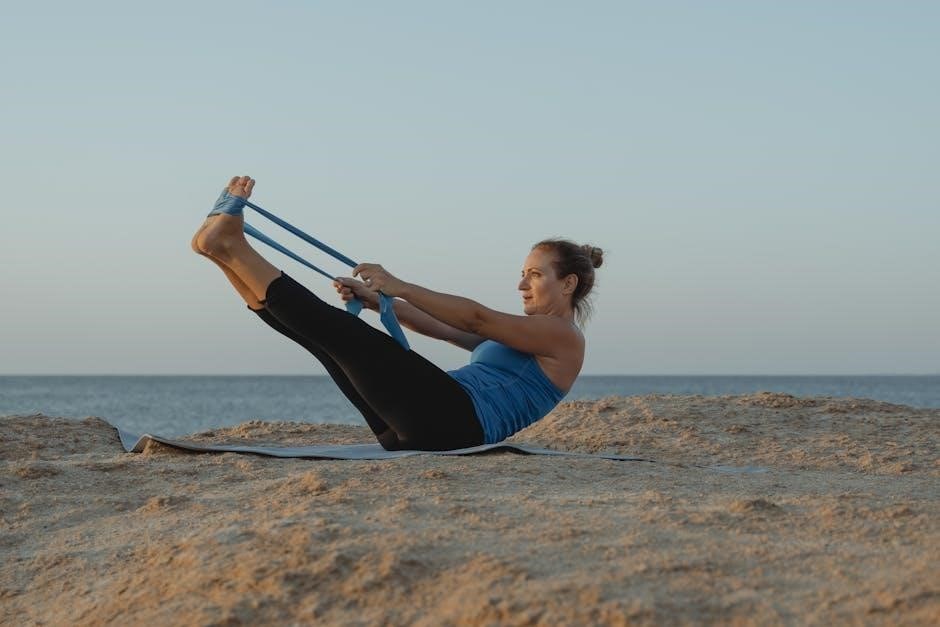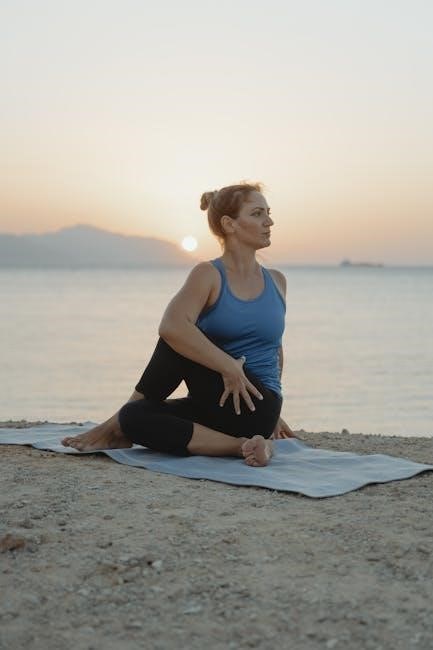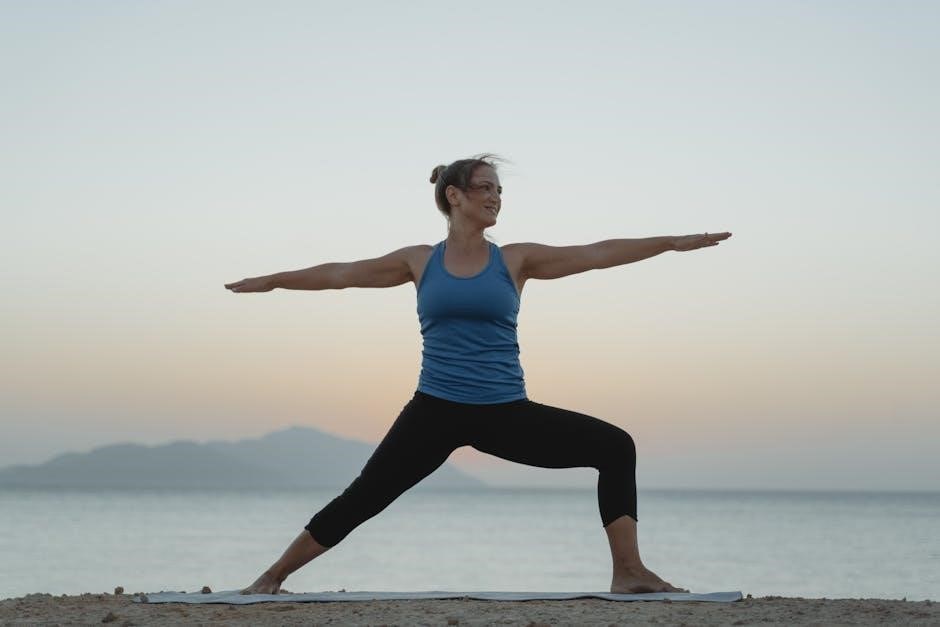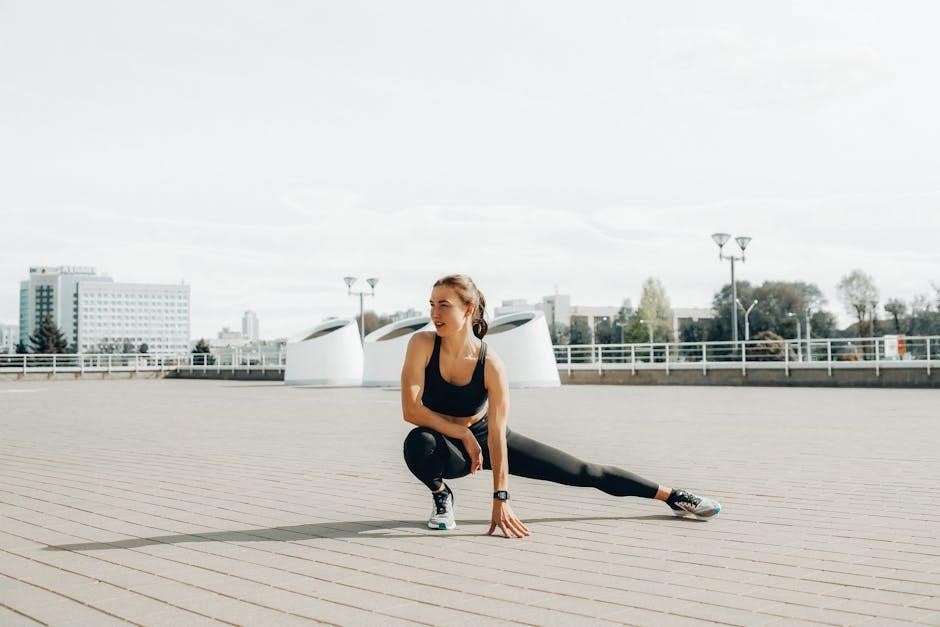PNF stretching is an advanced flexibility technique combining stretching and muscle contraction‚ widely used in sports and rehabilitation. PDF guides offer detailed routines and exercises.
1.1 What is PNF Stretching?
PNF (Proprioceptive Neuromuscular Facilitation) stretching is an advanced technique combining passive stretching and muscle contraction. It enhances flexibility and strength by engaging the nervous system. Commonly used in sports and rehabilitation‚ PNF involves assisted stretching to activate muscle groups‚ promoting relaxation and lengthening. Techniques like hold-relax and contract-relax are central to its practice. PDF guides provide detailed exercise routines‚ making it accessible for both athletes and individuals recovering from injuries. Its effectiveness lies in improving range of motion and reducing muscle tension through neuromuscular engagement.
1.2 Brief History of PNF Stretching
PNF stretching was developed in the 1940s by physical therapists Herman Kabat‚ Margaret Knott‚ and Dorothy Voss. Initially used to aid rehabilitation‚ it focused on improving movement in clients with spasticity. Over time‚ its benefits expanded to sports and fitness‚ enhancing flexibility and strength. Today‚ PNF techniques are widely used‚ with detailed routines available in PDF guides for easy access and implementation in various training and therapeutic settings.
1.3 Importance of PNF Stretching in Modern Fitness
PNF stretching is integral to modern fitness due to its versatility and effectiveness. It enhances flexibility‚ strength‚ and neuromuscular coordination‚ making it ideal for both rehabilitation and athletic training. By addressing muscle imbalances and improving movement patterns‚ PNF techniques prevent injuries and optimize performance. Accessible through detailed PDF guides‚ these exercises are widely adopted by therapists‚ coaches‚ and individuals seeking comprehensive fitness solutions.

Benefits of PNF Stretching
PNF stretching enhances flexibility‚ strength‚ and neuromuscular coordination while reducing muscle soreness and injury risk. Its techniques improve overall performance‚ making it a valuable tool in fitness and rehabilitation.
2.1 Improved Flexibility and Range of Motion
PNF stretching significantly enhances flexibility by targeting specific muscle groups and their surrounding connective tissues. By engaging the nervous system‚ it allows for deeper stretches‚ reducing muscle stiffness. This technique improves joint mobility‚ enabling a greater range of motion‚ which is essential for both daily activities and athletic performance. Regular PNF stretching can also correct muscle imbalances‚ promoting better posture and movement efficiency‚ making it a highly effective method for long-term flexibility improvements. Its controlled nature ensures sustainable results without overstretching.
2.2 Enhanced Muscle Strength and Neuromuscular Coordination
PNF stretching enhances muscle strength by engaging specific muscle groups through controlled contractions and stretches. This method improves neuromuscular coordination by refining communication between muscles and the nervous system. Strengthening occurs as muscles adapt to the demands of the stretching process‚ particularly in the core and stabilizing muscles. Improved coordination enhances movement efficiency‚ reducing the risk of injury and boosting overall physical performance. Regular PNF practice can also re-educate muscles‚ ensuring they work synergistically for optimal strength and functional movement patterns.
2.3 Reduced Muscle Soreness and Injury Risk
PNF stretching helps reduce muscle soreness by improving blood flow and lymphatic drainage‚ which removes waste products like lactic acid. This method also strengthens muscles and connective tissues‚ making them more resilient to strain. By enhancing flexibility and neuromuscular control‚ PNF exercises lower the risk of injuries during physical activities. Strengthening stabilizing muscles further protects joints‚ reducing the likelihood of overstretching or tears. Regular practice improves overall muscle health‚ making it an effective tool for injury prevention and recovery.
2.4 Applications in Sports and Rehabilitation
PNF stretching is widely used in sports to enhance performance and prevent injuries. Athletes benefit from improved flexibility and strength‚ enabling better power and endurance. In rehabilitation settings‚ PNF helps restore movement after injuries or surgeries by targeting specific muscle groups. It’s particularly effective for recovering joint mobility and strength. Therapists often combine PNF with other techniques to accelerate recovery. Its versatility makes it a cornerstone in both sports training and physical therapy‚ addressing a range of needs for athletes and patients alike.

Core Principles of PNF Stretching
PNF stretching relies on proprioceptive input‚ muscle activation‚ and reflexes to enhance flexibility and strength‚ utilizing techniques like isometric contractions and functional movement patterns for optimal results.
3.1 Proprioceptive Input and Muscle Activation
PNF stretching emphasizes proprioceptive input‚ which involves sensory feedback from muscles and joints to enhance movement awareness. By activating specific muscle groups‚ it improves neuromuscular coordination and flexibility. This principle engages the nervous system to control contractions and relaxations effectively‚ ensuring targeted stretching. Proper activation aligns with functional movement patterns‚ minimizing injury risk while maximizing range of motion and strength gains. This approach ensures efficient and safe stretching‚ making it highly effective for both rehabilitation and athletic training scenarios.
3.2 The Role of Stretch Reflex in PNF Techniques
The stretch reflex plays a crucial role in PNF stretching by triggering a natural neuromuscular response. When a muscle is stretched‚ the stretch reflex causes it to contract‚ which PNF techniques counteract by incorporating controlled contractions and relaxations. This process inhibits the reflex‚ allowing for deeper‚ safer stretches. By understanding and managing the stretch reflex‚ PNF enhances flexibility and strength while minimizing injury risk‚ making it highly effective for improving mobility and athletic performance in various training and rehabilitation contexts.
3.3 Use of Isometric Contractions in Stretching
Isometric contractions are a key component of PNF stretching‚ involving brief‚ controlled muscle activations without movement. These contractions engage the nervous system‚ enhancing neuromuscular coordination and muscle recruitment patterns. By targeting specific muscles‚ isometric contractions help reduce muscle spasms and improve joint stability. This technique is particularly effective in rehabilitation and sports training‚ as it strengthens muscles while preparing them for stretching. Regular use of isometric contractions in PNF routines can lead to improved flexibility‚ strength‚ and overall athletic performance.
3.4 The Concept of Functional Movement Patterns
Functional movement patterns in PNF stretching mimic natural‚ multi-planar movements‚ enhancing coordination and muscle recruitment. Unlike static stretches‚ these patterns engage multiple joints and muscle groups simultaneously‚ improving dynamic flexibility and strength; By replicating real-life movements‚ they address imbalances and enhance proprioception. This approach reduces injury risk and boosts performance‚ making it ideal for both rehabilitation and sports training. Incorporating functional patterns ensures that stretching translates effectively into everyday activities and athletic endeavors‚ promoting overall movement efficiency and longevity.

PNF Stretching Techniques
PNF stretching techniques involve controlled muscle contractions and relaxations to enhance flexibility and strength. These methods are highly effective for improving range of motion and reducing stiffness.
4.1 Hold-Relax Technique
The Hold-Relax technique involves isometrically contracting a muscle group against resistance for 5-10 seconds‚ followed by relaxation. This method targets specific muscles‚ enhancing flexibility and reducing muscle tension. It is particularly effective for improving range of motion and addressing tightness. The process involves a slow‚ controlled movement‚ making it suitable for both rehabilitation and general fitness. Regular practice of the Hold-Relax technique can lead to significant improvements in joint mobility and muscle balance‚ making it a cornerstone of PNF stretching exercises.
4.2 Contract-Relax Technique
The Contract-Relax technique involves actively contracting the target muscle group for 5-10 seconds‚ followed by a brief relaxation phase. This method leverages the body’s natural response to muscle contraction to increase flexibility. By engaging the muscle and then releasing tension‚ it helps reduce muscle spasm and improve joint mobility. The Contract-Relax technique is widely used in both therapeutic and sports settings to enhance range of motion and neuromuscular efficiency‚ making it a versatile tool in PNF stretching exercises.
4.3 Hold-Relax with Opposing Muscle Contraction
The Hold-Relax with Opposing Muscle Contraction technique involves stretching a target muscle while the opposing muscle contracts isometrically. This method enhances flexibility by activating the nervous system’s relaxation response. The opposing muscle’s contraction helps reduce resistance in the target muscle‚ allowing for a deeper stretch. This technique is particularly effective for improving joint mobility and reducing muscle tension‚ making it a valuable component of PNF stretching exercises for both rehabilitation and sports performance.
4.4 Repeated Stretch Technique
The Repeated Stretch Technique involves cyclic stretching of a muscle group‚ with short periods of relaxation between stretches. This method gradually increases flexibility by reducing muscle spindle tension over multiple cycles. Each stretch phase is followed by a brief relaxation‚ allowing for progressive lengthening of the muscle. This technique is effective for improving range of motion and reducing muscle stiffness‚ making it a versatile option for various PNF stretching exercises aimed at enhancing flexibility and mobility.

Common PNF Stretching Exercises
Common PNF stretching exercises target major muscle groups‚ improving flexibility‚ strength‚ and range of motion. They include hamstrings‚ quadriceps‚ latissimus dorsi‚ and upper trapezius stretches‚ suitable for both fitness and rehabilitation;
5.1 Hamstring PNF Stretch
The Hamstring PNF Stretch targets the posterior thigh muscles‚ enhancing flexibility and reducing muscle tension. It involves contracting the hamstrings against resistance‚ then relaxing and stretching. This technique often uses a partner or strap for assistance. To perform‚ lie on your back‚ lift one leg toward your chest‚ and activate the hamstrings by gently pushing against the resistance. Hold for 5-10 seconds‚ relax‚ then gently stretch the hamstrings. Repeat 2-3 times for optimal results‚ focusing on the hamstrings and calves.
5.2 Quadriceps PNF Stretch
The Quadriceps PNF Stretch focuses on the front thigh muscles‚ improving flexibility and reducing tightness. To perform‚ stand with one hand against a wall for balance. Bend one knee‚ bringing the heel toward your buttocks‚ and gently contract the quadriceps by pushing the foot against your hand or a strap. Hold for 5-10 seconds‚ then relax and gently stretch the quadriceps. Repeat 2-3 times on each leg‚ ensuring proper form to avoid strain and maximize the stretch’s effectiveness.
5.3 PNF Lat Stretch
The PNF Lat Stretch targets the latissimus dorsi muscles‚ enhancing posture and reducing back tension. Stand facing a stable object or use a strap. Contract the lats by pulling gently for 5-7 seconds. Relax and stretch forward‚ extending the shoulders. A partner can provide resistance. Perform 2-3 repetitions‚ ensuring controlled movements to maximize effectiveness and prevent strain. This stretch improves flexibility and reduces muscle soreness effectively.
5.4 Upper Trapezius PNF Stretch
The Upper Trapezius PNF Stretch focuses on relieving tension in the trapezius muscles‚ often tight from poor posture or stress. Sit or stand with good posture. Cross one arm across your chest‚ placing your hand on the opposite shoulder. Contract the trapezius by gently pulling toward your spine for 5-7 seconds. Relax and gently stretch forward‚ deepening the stretch. Repeat 2-3 times on each side. This technique enhances posture‚ reduces muscle tension‚ and improves shoulder mobility effectively.
5.5 PNF Hamstring Wall Slide
The PNF Hamstring Wall Slide targets the hamstrings and calf muscles. Stand with your back against a wall‚ knees slightly bent. Slowly slide down the wall‚ bending your knees to 90 degrees‚ and hold for 5 seconds. Contract the hamstrings by pressing your heels into the floor for 5-7 seconds. Relax‚ then slide back up the wall‚ stretching the hamstrings. Repeat 2-3 times. This technique improves flexibility‚ reduces muscle tightness‚ and enhances movement efficiency‚ making it ideal for both rehabilitation and athletic preparation.

PNF Stretching for Specific Muscle Groups
PNF stretching is applied to specific muscle groups to improve flexibility‚ strength‚ and functional movement. It targets lower extremities‚ upper body‚ and core muscles‚ enhancing sports performance and rehabilitation.
6.1 Lower Extremity PNF Stretching Exercises
Lower extremity PNF exercises target major muscle groups like hamstrings‚ quadriceps‚ and hip flexors. Techniques such as hold-relax and contract-relax improve flexibility and strength. These exercises enhance functional movement patterns‚ crucial for athletic performance and daily activities. They also reduce injury risk by increasing range of motion and neuromuscular coordination. Examples include the hamstring wall slide and hip flexor stretch. A PNF stretching PDF guide often provides detailed routines for lower limb exercises‚ ensuring proper technique and progression. Regular practice promotes balanced muscle development and injury prevention.
6.2 Upper Extremity PNF Stretching Exercises
Upper extremity PNF exercises focus on muscles like the shoulders‚ chest‚ and triceps to enhance flexibility and strength. Techniques such as hold-relax and contract-relax are applied to improve neuromuscular coordination. These exercises are beneficial for athletes and individuals with repetitive arm movements. Specific stretches include the PNF lat stretch and shoulder flexion exercises. A PNF stretching PDF guide often details these routines‚ emphasizing proper form to prevent injury and improve posture. Regular practice enhances functional movement and overall upper body mobility.
6.3 Core and Trunk PNF Stretching Exercises
Core and trunk PNF exercises target muscles like hamstrings‚ hip flexors‚ and lower back to improve stability and posture. Techniques include the PNF cat-cow stretch and PNF hamstring wall slide‚ which enhance spinal flexibility. These exercises also strengthen the abdominals and improve trunk mobility. Benefits include better postural alignment‚ reduced lower back tension‚ and enhanced functional movement. PNF stretching PDF guides often detail these exercises‚ emphasizing proper form and progression for both rehabilitation and fitness goals.

PNF Stretching in Rehabilitation
PNF stretching is widely used in rehabilitation to enhance recovery‚ improve joint mobility‚ and restore muscle function after injuries or surgeries‚ promoting faster return to activity.
7.1 Use of PNF in Post-Injury Recovery
PNF stretching is highly effective in post-injury recovery‚ enhancing tissue repair and promoting healing. It improves circulation‚ reduces muscle spasms‚ and restores range of motion. Techniques like hold-relax help gradually increase flexibility without causing further damage. PNF also strengthens muscles around injured areas‚ improving stability and reducing reinjury risk. Its adaptive nature makes it suitable for various stages of recovery‚ ensuring a safe and progressive return to normal function. This method is particularly beneficial for rehabilitation programs aimed at restoring strength‚ mobility‚ and overall athletic performance.
7.2 PNF for Clients with Spasticity and Hypertonus
PNF stretching is particularly beneficial for clients with spasticity and hypertonus‚ as it helps reduce excessive muscle tone and improve relaxation. Techniques like hold-relax and contract-relax activate inhibitory reflexes‚ decreasing muscle spasms. PNF enhances neuromuscular control‚ promoting more normalized movement patterns. Regular use can improve joint mobility‚ reduce discomfort‚ and enhance functional abilities. It is often incorporated into rehabilitation programs for individuals with neurological conditions‚ offering a tailored approach to manage spasticity and hypertonus effectively.
7.3 PNF Techniques for Improving Joint Mobility
PNF techniques are highly effective for enhancing joint mobility by incorporating controlled movements and neuromuscular activation. Methods like hold-relax and contract-relax help reduce stiffness and improve range of motion. PNF stretching encourages functional movement patterns‚ making joints more adaptable to daily and athletic demands. Regular practice can minimize joint restrictions and promote healthier articulation. These techniques are especially valuable in rehabilitation settings‚ aiding in the restoration of mobility and reducing the risk of chronic joint-related issues;

PNF Stretching in Sports Performance
PNF stretching enhances athletic performance by improving flexibility‚ power‚ and speed. It strengthens muscles and boosts neuromuscular coordination‚ essential for sports. Regular use optimizes training routines.
8;1 Enhancing Athletic Performance with PNF
PNF stretching boosts athletic performance by increasing flexibility‚ muscle strength‚ and neuromuscular coordination. It enhances explosive power and speed‚ crucial for sports. By targeting specific muscle groups‚ PNF improves movement efficiency‚ reducing muscle imbalances. Techniques like isometric contractions and dynamic stretches prepare athletes for high-intensity activities‚ optimizing pre- and post-workout routines. Regular use of PNF stretching exercises‚ as outlined in PDF guides‚ can elevate performance in sports like sprinting‚ jumping‚ and team activities‚ making it a valuable tool for athletes seeking a competitive edge.
8.2 PNF Stretching for Improved Power and Speed
PNF stretching enhances power and speed by improving neuromuscular efficiency and muscle activation. Techniques like isometric contractions and dynamic stretches increase explosive force‚ enabling faster movements. Reduced muscle soreness and improved flexibility allow athletes to train harder and recover quicker. PNF exercises‚ detailed in PDF guides‚ target key muscle groups‚ optimizing energy transfer and coordination. This makes PNF stretching a powerful tool for enhancing athletic performance in sports requiring rapid acceleration and high-energy output.
8.3 Application of PNF in Pre- and Post-Workout Routines
PNF stretching is highly effective in pre- and post-workout routines to enhance performance and aid recovery. Pre-workout‚ it activates muscles‚ improves joint mobility‚ and prepares the nervous system for exercise. Post-workout‚ it reduces muscle tension‚ prevents soreness‚ and restores flexibility. PDF guides often include routines that combine dynamic and static stretches‚ ensuring a balanced approach. Incorporating PNF into these routines optimizes training efficiency and supports long-term muscle health‚ making it a valuable addition to any fitness regimen.

How to Perform PNF Stretching Safely
Ensure proper warm-up‚ use controlled movements‚ and avoid bouncing. Focus on pain-free ranges and breathe naturally. Stop if discomfort occurs to prevent injury and promote safe practice.
9.1 Guidelines for Proper Technique
Proper PNF stretching technique involves slow‚ controlled movements to avoid injury. Always warm up beforehand and focus on pain-free ranges of motion. Breathe naturally‚ avoiding breath-holding‚ and use a partner or therapist for resistance when needed. Start with submaximal contractions to engage muscles effectively‚ then gradually increase intensity. Ensure joints are stabilized during stretches‚ and progress slowly to maintain safety and maximize benefits. Follow structured routines from reliable PNF stretching exercises PDF guides to achieve optimal results.
- Warm up thoroughly before starting.
- Use controlled‚ non-bouncy movements.
- Focus on pain-free ranges of motion.
- Breathe naturally throughout the exercise.
- Use a partner or therapist for resistance when needed.
- Start with submaximal contractions and progress gradually.
- Ensure joint stabilization during stretches.
- Follow structured routines from reliable guides.
9.2 Importance of Warm-Up Before PNF Stretching
A proper warm-up is essential before PNF stretching to prepare the muscles and nervous system. It increases blood flow‚ muscle temperature‚ and elasticity‚ reducing injury risk. Dynamic stretches‚ light cardio‚ or mobilization exercises are effective choices. Warming up enhances neuromuscular coordination‚ essential for PNF techniques. It also improves joint mobility and reduces muscle soreness post-stretch. Always dedicate 5-10 minutes to warm-up to optimize the effectiveness and safety of PNF stretching exercises‚ as outlined in many PNF stretching exercises PDF guides.
- Increases blood flow and muscle temperature.
- Reduces risk of injury and muscle soreness.
- Enhances neuromuscular coordination.
- Improves joint mobility and flexibility.
- Prepares the body for PNF techniques.
9.3 Avoiding Common Mistakes in PNF Stretching
To maximize the benefits of PNF stretching‚ it’s crucial to avoid common mistakes. Bouncing or forcing stretches can cause injury‚ while neglecting proper breathing may reduce effectiveness. Skipping the contraction phase or holding stretches too briefly can limit results. Overlooking proper alignment or using excessive force can lead to poor outcomes. Always follow techniques as outlined in PNF stretching exercises PDF guides to ensure safety and effectiveness. Consistency and patience are key to achieving optimal flexibility and strength.
- Avoid bouncing or forcing stretches.
- Do not skip the contraction phase.
- Hold stretches for the recommended duration.
- Focus on proper breathing and alignment.
- Use controlled‚ gentle movements.

Finding and Using PNF Stretching PDF Resources
Discover comprehensive guides on PNF stretching exercises in downloadable PDFs‚ offering detailed techniques to improve flexibility‚ strength‚ and proper form for optimal results and safety.
10.1 Where to Find Reliable PNF Stretching PDF Guides
Reliable PNF stretching PDF guides can be found through academic websites‚ fitness organizations‚ and professional physical therapy resources. Websites like PubMed‚ university repositories‚ and reputable fitness platforms often provide evidence-based guides. Look for PDFs from certified trainers or healthcare professionals to ensure accuracy and safety. These guides typically include detailed instructions‚ diagrams‚ and routines tailored for specific muscle groups or fitness levels. Always verify the source to ensure the information is credible and up-to-date.
10.2 Key Features to Look for in a PNF Stretching PDF
A reliable PNF stretching PDF should include clear instructions‚ step-by-step photos or diagrams‚ and detailed muscle group focus. Look for guides that emphasize proper technique‚ safety precautions‚ and progression methods. Ensure the PDF is authored by a certified professional‚ such as a physical therapist or fitness expert. It should also provide variations for different fitness levels and include tips for modifying stretches. High-quality visuals and easy-to-follow layouts are essential for effective learning and implementation of PNF techniques.
10.3 How to Use a PNF Stretching PDF Effectively
To maximize the benefits of a PNF stretching PDF‚ start by reviewing the content thoroughly. Begin with a dynamic warm-up to prepare your muscles. Follow the step-by-step instructions and visuals carefully‚ ensuring proper form. Focus on one muscle group at a time‚ and gradually progress the intensity. Practice consistently‚ incorporating the stretches into your routine 2-3 times a week. Track your progress and adjust as needed. For best results‚ combine PNF stretching with other training methods and consult a professional if unsure about any technique.
PNF stretching exercises PDF guides offer a comprehensive approach to improving flexibility and strength. Regular practice enhances mobility and reduces injury risk‚ making it a valuable addition to any fitness routine.
11.1 Recap of PNF Stretching Benefits and Techniques
PNF stretching combines muscle contractions and stretching to enhance flexibility‚ strength‚ and neuromuscular coordination. Techniques like hold-relax and contract-relax improve range of motion‚ reduce muscle tension‚ and prevent injuries. Regular practice boosts athletic performance and supports rehabilitation. PDF guides provide structured routines‚ making it easier to incorporate PNF into daily workouts. Consistency is key to achieving long-term benefits‚ ensuring improved mobility and overall physical function. PNF stretching is a versatile and effective method for both fitness enthusiasts and individuals recovering from injuries.
11.2 Encouragement to Incorporate PNF Stretching into Daily Routine
Incorporating PNF stretching into your daily routine can significantly enhance flexibility‚ strength‚ and overall well-being. With accessible PDF guides‚ you can easily follow structured exercises tailored to your fitness goals. Consistency is key‚ as regular practice leads to improved mobility and reduced muscle tension. Start with short sessions and gradually increase intensity. Embrace PNF stretching as a long-term investment in your physical health‚ ensuring better performance in sports‚ rehabilitation‚ and everyday activities. Make it a habit for lasting benefits.
